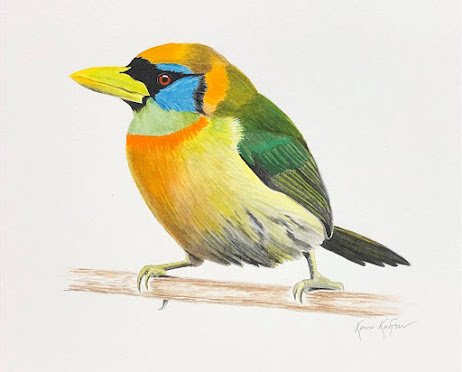Random Bird: South Georgia Pipit
 |
| South Georgia Pipit (Anthus antarcticus) |
Take this one. It's not large, it's not colorful, it doesn't have the most interesting song. But it lives in an amazing place. This is a South Georgia Pipit. It isn't found in the state of Georgia in the U.S., and it isn't found in the former Soviet republic of Georgia. No, this bird lives only on South Georgia Island, out where the South Atlantic meets the Antarctic Ocean.
South Georgia is huge, wild, remote. About 100 miles long and up to 23 miles wide, it is crowned with snow-capped peaks that rise as much as 9000 feet in the air. The island and the surrounding waters are home to many large and spectacular creatures: seals, whales, penguins, albatrosses, various other seabirds. This is also home to the small, inconspicuous South Georgia Pipit, which lives nowhere else in the world. The pipit is the only songbird on the island.
I have been lucky enough to visit South Georgia four times, as a lecturer on expedition cruises. Kimberly and I both visited there in January 2009, helping to lead a cruise for Victor Emanuel Nature Tours. Of course we spent much of our time admiring the Wandering Albatrosses and King Penguins, but we also watched the small, drab South Georgia Pipits.
 |
| South Georgia Pipit. It may not look like much, but it's amazing that this bird even exists. |
Historically, the pipit probably was abundant all over the lowlands of South Georgia. Today it is confined to a few tiny offshore islets and to a few small bays surrounded by ice or sheer cliffs. Why? Because rats have colonized most of the main island. Rats, coming ashore from early sailing vessels, have spread over most of the island, wiping out all but the largest birds. I have thought about this while hiking around South Georgia, across hillsides that once rang with the flight-songs of pipits. Today there is no sound but the wind sighing through the grass. It's like a land of ghosts. Go to a small offshore island like Prion Island, where we took these photos, an island teeming with pipits and with all kinds of seabirds, and you get a glimpse of what the main island would have been like at one time.
There's a project now under way to try to eradicate the rat population from South Georgia. I don't know if it's even possible; we're talking about an island with a surface area of more than 1,300 square miles. But if the project succeeds, the South Georgia Pipit, now hanging on by a thread, may become numerous again in its remote and limited range.
 |
| South Georgia Pipit: Will it have a brighter future? |



Comments
Post a Comment